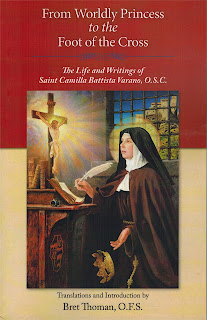Sunday October 17 2010, Pope Benedict XVI elevated to sainthood Camilla Battista of Varano, OSC, in a ceremony at St. Peter’s Square at the Vatican.
Biographical Profile Blessed BATTISTA CAMILLA wasborn in Camerino, Italy, on April 9, 1458, of Prince JuliusCaesar da Varano and Lady Cecchina di Maestro Giacomo. Although she was born out of wedlock, nonetheless, Camilla was reared in the palace of her father. There she received a suitable instruction in the arts and literature under the tutelage of Giovanna Malatesta, the wife of the Prince.
Around the agesof 8-10, after having heard the exhortation of the preacher Fr. Domenico da Leonessa, she made a vow to meditate every Friday on the Passion of Christ and to shed at least one tear. This simple endeavor, which she embraced with childlike enthusiasm and faithfulness even if it cost sacrifices, opened before her the unfathomable treasures of grace, enabling her to lead an intense spiritual life. About this resolution she wrote, “That holy word, which I uttered, moved by the Holy Spirit, made such an impression on my tender and childlike heart that it never left my mind and heart.” Yearslater, another Franciscan, Fr. Pacifico of Urbino, encouraged Camilla to persevere in her vow.
Then from the agesof 18-21, she went through three yearsof deep spiritual struggles against the allurements of the world. Yet, she would not abandon her suffering Lord; on the contrary, for the sake of his love she began to lead a more austere way of life. Referring to thisperiod of her life, she wrote, in fact, “Blessed is that creature who never gives up under any temptation the good she began!”
During Lent of 1479 on the vigil of the Annunciation in the Church of St. Peter in Muralto, Camilla listened to the preaching of Br. Francesco da Urbino. While doing so, she received the light to understand the inestimable gift of consecrated virginity. So, on the Octave of Easter, after having made a general confession to Fr. Oliviero da Urbino, she obtained the gift of a total inner purification.
Having thus prepared herself to belong to Christ totally and having overcome parental resistance for two years, she managed to enter the monastery of the Poor Clares of Urbino on Nov. 14, 1481, taking upon the religiousname of Sr. Battista—a common name for a woman of the time. She returned to Camerino on the first week of January of 1484 with eight other of her companions; and on Jan. 4, she gave start to a new community of Poor Clares in a monastery which her father had purchased from the Olivetan monks.
The time had come for the Blessed to face trials. The first one was spiritual dryness, which lasted for a period of 5 years from 1488 to 1493. During that time, she experienced the silence of Him who was the only reason for her life. The eco of this spiritual desolation is well documented in the autobiographical letter known as“the Spiritual Life”. The second trial wounded her deeply in the heart, when Pope Alexander VI excommunicated her father for having resisted the limits set on the Lordship of Camerino. He was then imprisoned along with her three brothersby Cesare Borgia, who later had them slain on Oct. 9, 1502. Because of this tragic incident, Camilla had to flee to the city of Fermo, where she sought refuge to no avail. She was able, nonetheless, to seek asylum in the Kingdom of Naples thanks to Isabella Piccolomini Todeschini, the wife of Matthew Acquaviva of Aragona. It wasnot until the death of Pope Alexander VI on Aug. 8, 1503, that she was able to return to Camerino, where her youngest brother, Giovanni Maria, was able to restore the Lordship of the Varano family.
Then, on Jan. 28, 1505, Pope JuliusII, who admired Camilla, sent her to found a new community of Poor Claresin the city of Fermo, where she stayed for two years. She was also able to form the new community of Poor Claresof Saint Severino Marchesduring the years of 1521-22. Her spirit of charity enabled her to serve her sisters in many ways in their spiritual formation; by writing a treatise requested by a religious entitled, “The Purity of the Heart”; by interceding for those on death rows; and by saving the city of Treia from mercenary troops.
According to the witness of one of the sisters, there was place in Camilla’s heart for the whole Church of Christ, for whom she prayed and suffered. She suffered for the sins of many clergymen, and her heart was acutely pained over the news reaching her from Germany, where an Augustinian monk, Martin Luther, was fighting to sever ties with the Roman Catholic Church.
When she had reached the age of 66, of which 43 were spent in the intimacy of the cloister life, her yearning “to leave the prison of her body in order to be with Christ” was satisfied. She died in silence on May 31, 1524, due to a plague that broke out in the Monastery of Camerino, where her mortal remains can be found to this day.




No comments:
Post a Comment